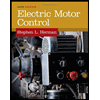
Explain the reason why direct current (DC) controller can be called as a counter emf controller.
Answer to Problem 1SQ
DC controller can be called as a counter emf controller because the counter emf of the armature is used for controlling the motor acceleration.
Explanation of Solution
In DC motor, the generated counter electromotive force is proportional to the speed of the motor for constant field. The counter emf can differ from the applied voltage only by armature drop.
DC controller can automatically adjust the starting time intervals, based upon the connected load. If heavy load is connected, it has more inertia to overcome; therefore, long time is required to generate the counter emf. When the DC motor starts, counter emf produced across the armature is very low. As the acceleration of motor increases, the counter emf increases. If the voltage value across the armature reaches a particular value, the starting resistance can be reduced at the correct time by actuating the relay. Therefore, the counter emf is mainly responsible to control the acceleration of motor.
Conclusion:
Thus, the DC controller can be called as a counter emf controller because the counter emf of the armature is used for controlling the motor acceleration.
Want to see more full solutions like this?
Chapter 46 Solutions
EBK ELECTRIC MOTOR CONTROL
- Solve this problem and show all of the workarrow_forwardSolve this problem and show all of the workarrow_forwardA 3 km long multimode step index fibre operating at a bandwidth of 4 Mhz has a core refractive index of 1.48 and a refractive index difference of 1 %. Evaluate the rms pulse broadening per kilometer which results from chromatic dispersion.arrow_forward
- Find the Thevenin Equivalent of the circuit below, show all steps;arrow_forwardFind the Thevenin Equivalent Circuit of the following and find the current through R_L, show all steps;arrow_forwardFind the Thevenin Equivalent Circuit of the circuit below and the current through R_L , show all steps;arrow_forward
- Find the Norton Equivalent of the below and the voltage across R_L, show all steps;arrow_forwardUse Mesh Analysis to find the current through the laod resistor R_L. Show all steps;arrow_forwardFind Thevenin Equivalent of the circuit below and the current through the load resistor R_L. Show all steps;arrow_forward
- If = 5000 A actual time IDMT ---R,, Reand R3 The Tsm relays R, and R3 Draw The characteistic relays time margin between Tsm = 0.5 RCT=500/1 CS-125% TSM = 2 TSM = 0.2 and -0.6 R2 CTS = 500/1 Cs=100% Tsm=0.4 R3 CTS = 400/1 Cs=125% TSM = 2arrow_forwardLet X and Y be random variables having joint density function 01.5). (c) p(x) and p(y).arrow_forwardThe joint density function of two continuous random variables X and Y is: p(x, y) = {cxy 0 < x < 4,1 < y < 5 0 otherwise Find (i) the constant c (ii)P(1arrow_forwardarrow_back_iosSEE MORE QUESTIONSarrow_forward_ios

 Electricity for Refrigeration, Heating, and Air C...Mechanical EngineeringISBN:9781337399128Author:Russell E. SmithPublisher:Cengage Learning
Electricity for Refrigeration, Heating, and Air C...Mechanical EngineeringISBN:9781337399128Author:Russell E. SmithPublisher:Cengage Learning

